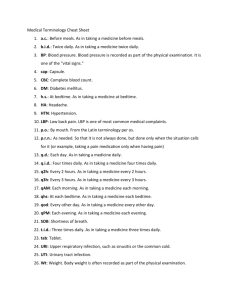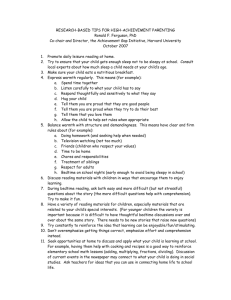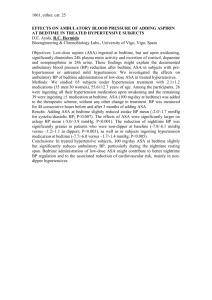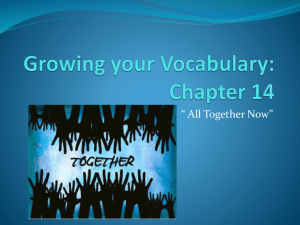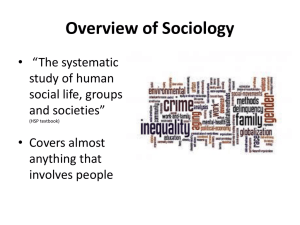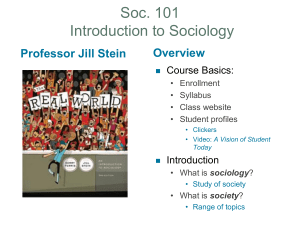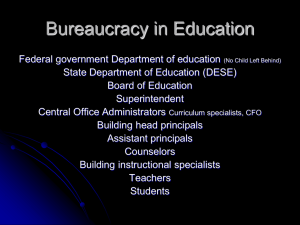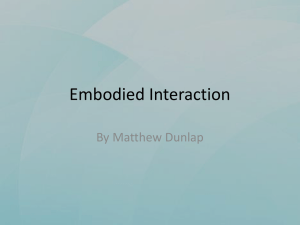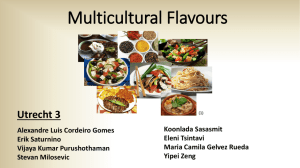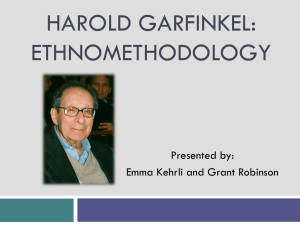Dr. Mark Rouncefiled Ethnomethodology At Play
advertisement
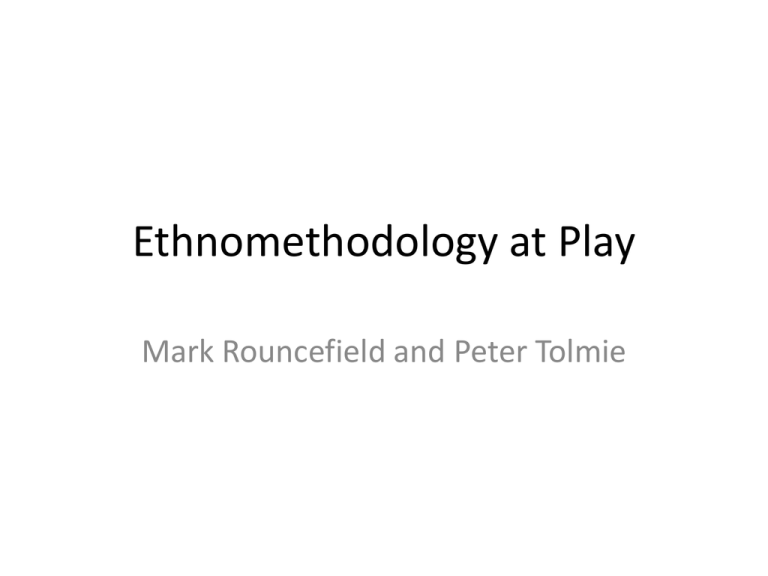
Ethnomethodology at Play Mark Rouncefield and Peter Tolmie Garfinkel’s Bastards at Play • The usual apologies.. • Play is a commonplace word - we use ‘play’ as a simple ordering device • Contrast with conventional sociological studies demonstrates the breadth of EM analysis • ‘play’ involves ‘work’ - all activities, even ‘play’, involve ‘work’: ‘For the ethnomethodologist there is no domain of human practice that is exempt from this. Human action and interaction does not just tumble from the sky ready formed. Instead, even the most mundane of actions have to be produced somehow, somewhere, somewhen. This is a job of work’ Sociology and Play • Sociology - ‘the attempt to discover what is social about the social world.’ • But Sociology uses ‘play’ for further rehearsal of explanatory themes they have found to be interesting and relevant elsewhere • Don’t tell us very much about leisure activities themselves – marginalized or sacrificed in pursuit of other disciplinary, political and theoretical goals. • The analysis of sport becomes ‘the docile matrix for the exercise of a theoretical will’ Standing Out while Fitting In: Serious Leisure Identities and Aligning Actions among Skydivers and Gun Collectors • One of the most enduring expressions within the skydiving argot is the maxim, ‘Eat, Fuck, Skydive!’ By designating skydiving as belonging to the same basic category as eating and intercourse, the expression underscores the sensual, hedonistic character of the experience and implies that people skydive for the same reasons that they engage in the other two activities … Intertwined with the foregoing themes in skydiving subculture is … an ethos of ‘hyperheterosexuality’ and male dominance. While skydiving culture has been changing in recent years in ways that may be reducing this patriarchal hegemony, the change is variable across the skydiving community, where hyperheterosexuality and male dominance continue to be strong, if not as hegemonic, as in the past. Yet More Ranting.. • What’s this? - ‘a complex “material interaction” between the material capital that is in the objects of the kit and the embodied capital that is in the body of the sailor.’ • Sociology risks ‘hiding the phenomena’ behind an analysis of the forces that supposedly shape the form, structure and experience of play. • Sociology seems to presume that its problems are theoretical - as if; ‘persons live out the lives they do, have the children they do, feel the feelings, think the thoughts, enter the relationships they do, all in order to permit the sociologist to solve his theoretical problems.’ Ethnomethodology and Play • Garfinkel – ‘do I have all the parts?’; Sudnow; Livingston etc etc • Goode - Playing with My Dog Katie: An Ethnomethodological Study of Dog-Human Interaction (Goode 2007) : • This book is an attempt to display in detail a guardian playing with his dog, an instance of just that. That people play with dogs is in itself, in its own right, a ‘miracle of everyday society’. I am not saying that play between companion dogs and their guardians is (or is not) socially or politically important or consequential. It is more like when Sacks watched and analysed a videotape of a couple greeting each other at the door. He was not doing so to advance a political agenda- to change how people greet each other at doors, for example. He did it to discover and appreciate the incredible details in and of the simplest things we do • ‘to discover and appreciate the incredible details in and of the simplest things we do’ Bedtime Stories • Reading is a commonplace activity, visible across all walks of life and in virtually all human settings. • Early sociological interest outlined the various ways in which sociological issues, the ‘usual suspects’ of class and gender and social groupings, impacted on what, why, how and when people • More recently the focus of research on reading has largely moved away from an interest in the actual activity of reading towards an interest in the form, the physical mechanisms, the technologies, by which reading is accomplished – and scare stories telling us that such devices are ‘making us stupid’ (Carr 2008) or ‘lazy’ (Collins 2011). Bedtime Stories • use data gathered in domestic environments that concentrates upon the actual situated practices of reading stories to children at bedtime. • explore how reading is actually accomplished as a part of the daily fabric of life: • how it fits within the domestic routine; • who can do it where and when; • how it is actually visibly done; • how its visible character ramifies for others in the household; • how it is manifestly about leisure and pleasure Book Reading as Embodied • Many aspects of reading as a social phenomenon can be seen to turn upon its physical embodied character. In the following observations the mother (M) is reading a bedtime story to her daughter Sarah (S): • M picking up the book to sit down as S reaches out to her • M gets ready to open the book • M flicks through the pages • M opens the book • M lifts out the bookmark • M puts the bookmark on the arm of chair • M sorts out the dust jacket • M positioning the book to read • M holding the book in place as asking S to recall the last part • M flicking back to the prior chapter. • M flicking back to the current chapter. Book Reading as Embodied • • • • • • • • Some ways in which reading is embodied the manner of sitting; of holding one’s arms; of holding one’s hands; the angle of the head; the direction of the gaze; the actual relation and orientation to the book being held; each of these proceeds dynamically in order to accomplish something that amounts to ‘reading to your daughter’ and ‘being read to by your mother’. • Even the position of their heads is a feature of the embodied practices of reading. The focus is the book and the words on the page, - looking elsewhere becomes an accountable matter – as inattention or tiredness • But this isn’t just any old reading, this is ‘bedtime’ reading - child is ready for the bed, is physically tired and the mother is alert to these signs Reading is Manifest • Reading, by virtue of its embodied character, is also manifest to others • open to ordinary recognition and reasoning as a feature of the environment. • that someone is reading, just what they are reading, just where they are within the thing they are reading, how other things are organized around them, and so on, is all available to others in the setting, • carries a number of important implications for how others might orient to the reader. • competent member of the setting can see, ‘at-a-glance’, that ‘Mum is reading to Sarah’ and this in turn has implications for matters such as: can I interrupt?, can I listen in?, can I put the TV on or some music? and so on. • Manifestness here is what is audible. • Part of being a competent member of the setting is knowing, hearing, just what is being read as the current bedtime story to Sarah right now, • if the mother here was reading a book to her daughter in French, or it was the daughter herself who was reading to the mother, the scene could well be reasoned about as something else.. Book Reading has a Visible Order • It has a beginning: books are located, picked up and brought to readiness for reading. • There is a middle: books are ongoingly engaged with, with visible attention to the printed page, with the positioning of fingers just so for the fluid turning of the page, and so on. These things are only intelligible for what they are because of how they are ordered in relation to what has gone before. • There is an end: books are closed, perhaps bookmarks inserted or pages turned down, they are put to one side so that their very placement speaks to how they are done with for the present. • Bedtime reading has spatiotemporal characteristics - bedtime reading could happen anywhere but it doesn’t - reading has a particular time and place where members of the household will unproblematically see it for what it is.. Reading is a Feature of How Social Relations within a Household are Accomplished • • • • • • • • • • • M picking up book to sit down as S reaches out to her … M puts arm round S … M Straightening out book and resting hand on top of S’s head … M: ‘Don’t move’ breathed a voice in Torak’'s ear (stroking S’s head) … M: Pardon me. (Laughingly as continuing to stroke S’s head) He couldn’t see anything. He was huddled in a rotten smelling blackness with a knife pressed at his throat. He gritted his teeth to stop them chattering. (Shifting arm to put round S) S puts her hand on M’s … M strokes S’s head and rests her hand on her head, holding the book with one hand, as she continues S raises her arms to take hold of M’s hand … M moves her hand down and puts it on S’s knee S lifts her hand to hold M’s hand on her knee and M glances down and strokes her knee Kisses her on top of her head • What things like bedtime reading do is they quite neatly provide licence for those kinds of contact to happen without fuss or account and on a regular basis. • Thus bedtime reading is not just an opportunity for intimacy to occur or a place where, amongst other things, intimacy happens to be present. It is a mechanism for intimacy Another Example: Garfinkel’s Bastards Eat Tarte Tatin • Cooking is a mundane feature of everyday life, done by people around the world as a matter of necessity and, for some at least, as the business of pleasure • until relatively recently largely neglected by Sociology • Where cooking and eating has featured in sociological analysis it is often as an instantiation of some wider social process, such as the ‘civilising process’ (Elias 1969), or class and social structure (Goody 1982) or patriarchy and the subjection of women (Charles and Kerr 1988; Murcott 1983). • Our focus - explicating the mundane work involved in making a meal and the enjoyment members who do cooking for pleasure find in the enterprise. Mundane Competencies • figuring out what to eat .. • considerations that are brought to bear upon this most ordinary of daily concerns, including matters of domestic routine, lifestyle, diet, work-home-life balance, etc. • the sourcing of food and the different orders of working knowledge implicated in finding foodstuffs and assembling ingredients. • Cooking - the skilful use of heat, knives, pans, spices, herbs and seasoning; the subtle art of working with colour, texture, taste, smell and even sound, to transform base ingredients .. Making a List – Checking it Twice • A:. Tearing sheet from pad on noticeboard and holding it up: That’s what I've already got on there this week. • A takes the list to a chopping board on side and rests on it with pen poised: Er: right, I want some chicken breasts don’t I? (writes under previous items on list) I want some er (pen poised for a moment) Some chicken breasts. Puff pastry (writes underneath other items on list) Erm. • A: How am I doing for sugar (walks over towards shelves on other side of kitchen) (peers in jar and in packet). Got some more there, great. • A writes on list under prior items • A: Yeah, so let me check that then, have we got everything we need? • A: I might actually buy some bloody onions to save me going and fucking about on a dirty horrible day and getting stuff from the allotment. • Adds onions to the list • A: (Looking around kitchen) Er, I think that’s it isn’t it? Using the Senses • • • • • • • • • • • • Sniffing the pears A sniffs at pan on hob. A: (To P) Get your nose in that. P sniffs pan, then M has a sniff. M: You can smell the sugar can’t you. A: And you’re starting to smell the fruit. A has another sniff. A: Can you smell the pear in there? Coming through now? M comes over and has another sniff. M: Yes. There’s butter – The smell of butter is quite strong. A: Yes. A: It’s starting to come through. The sweetness is there and then the fruit is just percolating through in it. And that just becomes stronger and stronger as you go. So here’s a thing, with S. Y’know, one of the first things she often says is – er when she comes in the door is. That smells good. • Watching the pears • A: (gesturing to pan) Now basically what you’re doing there is to – because all together it gets cooked for about fortyfive minutes – you’re just making a caramel sauce. You’re just doing fruit in a caramel sauce with a lump of pastry on top, soaking it all up, y’know? It ain’t complicated. Leans over pan and studies it. Leans further in and sniffs. A shifts the position of the pan on the hob again and shakes it a little. Bends down and peers at it closely. A shaking pan then turning heat down a little. A: Let’s turn the heat up again (.) to get a bit more (.) It’s starting to need a little bit more colour. • • • • • • • : the sound of food • A stirring contents of saucepan with a wooden spoon. • A: Can you hear that? (.) it’s going too fast. • Stirs contents of pan again. • A: Too busy. • Turns down heat under pan. Stirs contents of pan around again. Leaves wooden spoon in pan … • Stirring pan with spoon. • A: That’s a nicer sound now. So What? • ‘Implications for Design’? • Reading and the ‘affordances’ of Technology • Cooking, shopping understanding Users.. • “New Technologies will succeed or fail based on our ability to minimise the incompatabilities between the characteristics of people and the characteristics of the things we create and use” (Casey) • “..it’s the source for the failures of technocratic dreams, that if only we introduced some fantastic new communication machine the world will be transformed. Where what happens is that the object is made at home in the world that has whatever organisation it already has.” (Sacks) Thank You Kindly – Questions?
